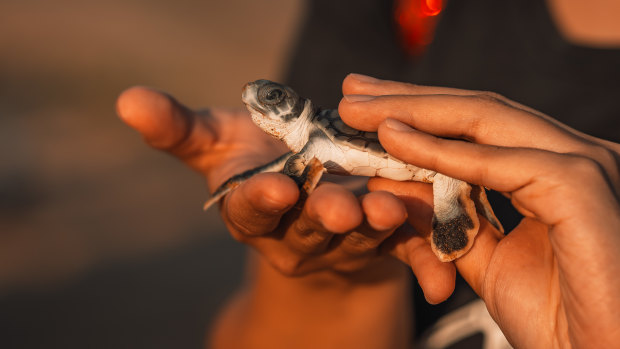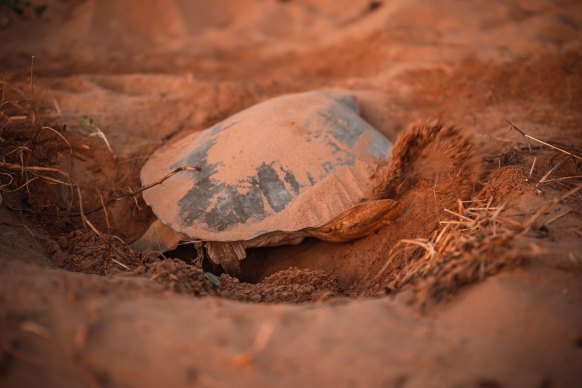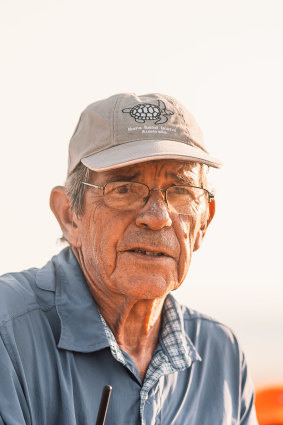Dinner, drinks and turtle nests at this remote Aussie island
Like soft, wet ping-pong balls, the perfectly spherical eggs are dropped into their sandy bunker, and the audience coos.

A hatchling gets a hand into the sea.Credit: Patch Clapp
The issuer of the eggs – a large, flatback turtle – is in a trance, and doesn’t seem to mind that her birthing bed is hemmed by staring humans.
If you’d asked me how I’d planned to spend the night in the Territory, I would have suggested drinking from fresh coconuts at a night market, sipping rosella-infused gin at Willings Distillery or ordering the barramundi at the waterfront Trailer Boat Club.
Eyeballing a turtle’s cloaca was not in the plan.
I’ve joined a Turtle Tracks tour by local operator Sea Darwin, and our little group of turtle tragics is gathered on Bare Sand Island/Njulbitjlk , 90 minutes by boat from Darwin’s wharves.
Jumping off the boat, we immediately hit the jackpot: within minutes, we’re watching the flatback dig an egg chamber that will house her offspring for the next two months.

Digging in.Credit: Patch Clapp
The remote island is uninhabited, save for volunteers from not-for-profit sea turtle research group AusTurtle , who are camped in the dunes.
While our turtle is in her laying trance, they measure her shell, check her tags and take the egg chamber’s temperature. Above 29.5C and the eggs will produce females; below, and they are baby boys; yet another knock-on effect of global warming.
According to our guide Natalie Robson, a marine biologist and PhD candidate studying male turtle behaviours, Bare Sand’s 900-metre beach is a hotspot for nesting turtles.
We’ve got to be extremely careful around flatback mothers, she warns. Unlike olive ridley and green turtles, Australia’s only endemic turtles are flighty creatures. If the sand’s too wet, too dry, too cold, too warm, or they’re spooked by humans, they won’t lay.
So we keep quiet, keep in a group, and turn our camera flashes off. There’s no splashing in the water, either, as Bare Sand has a few resident crocs. That’s so NT.
Tonight, our turtle will lay an average of 50 eggs at a depth of 50 centimetres, which will incubate for 50 days.
“Flatbacks are very kind to us; everything’s done in fifties,” AusTurtle founder Dr Mick Guinea tells me later. The volunteer group has about 1700 female flatbacks on its database, but the males live permanently at sea, feeding and following the ladies.

Dr Mick Guinea, the Turtle Whisperer.Credit: Patch Clapp
“The males are not very complicated,” adds Guinea, who’s known locally as the Turtle Whisperer. His first trip to Bare Sand was in 1990, and this year, AusTurtle volunteers were revisited by females they’d tagged back in 1996.
Incredibly, we don’t know the lifespan of flatback turtles. “They outlive the people that research them,” says Robson.
Their first 30 years, which scientists dub “the lost years,” are a lazy daze of grazing on Australia’s continental shelf before they reach sexual maturity, when only the females will come ashore to nest.
“We can tag and then track the females when they come on shore, but we don’t have the same access to males, unless we jump off the boat and onto their backs and tag them as they’re swimming,” says Robson, explaining her PhD work. “It’s called turtle rodeo.”
Meanwhile, our mum has finished laying, and sweeps sand across her eggs. “That’s about the only maternal thing she’ll do,” Robson observes, as the flatback shuffles surprisingly quickly back into the sea.
Each season, to ensure the survival of the fittest, the ladies mate with several males, storing the sperm throughout the year – and possibly longer – with enough DNA to start a new colony. They’ll either return faithfully to their birth island or nearby Grose, Indian or Quail Islands. “On almost every beach here, you could find a flatback turtle track,” says Guinea, and by September, the shores are awash with hatchlings racing to the mothering sea.
Although it’s early in the nesting season, the AusTurtle volunteers have rescued a little band of fresh hatchlings from a gull attack. All sea turtle species in Australia are either endangered or vulnerable to extinction, says AusTurtle, and they have a survival rate of just one in a thousand. And with the added impact of pollution, fishing and plastics – all the fault of humans – isn’t it our duty to give these 12-hour-old babes a helping hand?
“This is the best part of the job,” says AusTurtle volunteer Mark Barnes, as we lift them gently from the bucket and point their tiny faces to the dying sun, waiting for instinct to kick in. In moments, their tiny bodies are swept into the Timor Sea.
This being the Territory, I’m surprised no-one’s running a book on the race to the water.
Back on board our open-sided boat, dinner is a bento-style box of salads, prawns or roast chicken, with a glass of wine or beer, as the Top End turns on a spectacular sunset.
The enormous red orb sinks below the horizon, and unlike the hundreds who line the beaches at sunset in Darwin, we have the view all to ourselves. Just us and all the turtles in the deep blue sea.
THE DETAILS
TOUR
Sea Darwin Turtle Tracks Tours departs 4pm daily, May-September from Stokes Hill Wharf in Darwin. Costs $359 including dinner and drinks, seadarwin.com
MORE
See austurtle.org, northernterritory.com
The writer was a guest of NT Tourism.
Sign up for the Traveller Deals newsletter
Get exclusive travel deals delivered straight to your inbox. Sign up now.